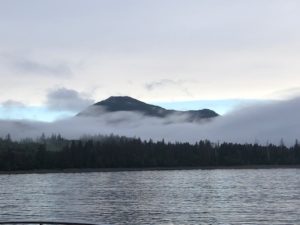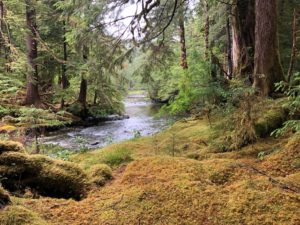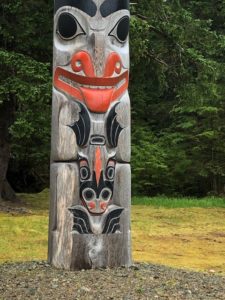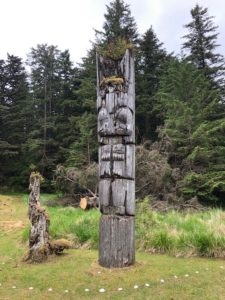
Haida Gwaii’s mist-covered islands are sheer magic. Photo by Robert Waite.
In this post, Part I of a two-part series, guest contributor and baby boomer Robert Waite chronicles his journey to little-visited Haida Gwaii, previously known as the Queen Charlotte islands, off the coast of British Columbia.
Part I offers an introduction to the tumultuous history and compelling culture of the islands, while part II will detail his voyage through them aboard the MV Cascadia, a small expedition ship that allows for shallow landings and coastal kayaking trips while balancing comfortable accommodations with environmental protection.
Getting to explore Haida Gwaii personally is a far cry from the distant views afforded from Alaska-bound cruise ships as they pass Haida Gwaii sailing along the Inside Passage, often in the dead of night. Like me, if you’ve made that trip, you may have wondered what you were missing on those islands. Now we know.
By Robert Waite
There are a handful of places I have experienced as a traveler that I would describe as magical.
Camping out on the Antarctic Peninsula would be one; spending time with mountain gorillas in Rwanda would be another. Venice in the evening (after the cruise ship hoards have left) comes to mind, as does Rapa Nui (better known as Easter Island).
To this short list I now add Haida Gwaii.
If you have never heard of it, do not fret. Although located in Canada, it is a safe bet that few Canadians, much less Americans, would know it by this name.
The archipelago, located off the northwest coast of British Columbia, was previously called the Queen Charlottes. Even under that moniker, most people east of the Canadian Rockies would have been hard-pressed to find it on a map.
With a wild Pacific west coast and the shallow, often tempestuous Hecate Straight to its east, Haida Gwaii and its peoples existed in relative isolation years after Vitus Bering explored the Alaskan coast or Capt. James Cook set foot on Australia or Hawai’i.
Long Isolated
This isolation for a time protected not only the indigenous people – the Haida – but also a vibrant biosphere, the coastal temperate rainforest.

Haida Gwaii’s temperate rainforest contains the richest biodiversity on earth. Photo by Robert Waite.
According to Oregon State entomologist Andy Moldenke, its forest floor and its canopy above are said to contain as many as two million creatures representing over 1,000 species — the richest biodiversity on earth on a per-square-meter basis.
Abundant rainfall and relatively mild temperatures nurture majestic forests. The surrounding ocean is also teeming with life, including several species of salmon, which return to its rivers and streams to spawn.
But Haida Gwaii’s isolation could not continue forever. The islands were “discovered” by Spaniard Juan Perez in 1774. In the early 1800s, however, the only real interest by outsiders was in the fur of the sea otter, which was harvested to near extinction by the Haida for trade – including trade for tools like steel chisels.
It was not until the mid-19th century that Europeans – by this point, the British and their Canadian subjects – fully turned their attention to the islands as an opportunity for exploitation.
Decimated by Foresters and Disease
Their interest was old-growth timber, especially the Sitka spruce, western red cedar and hemlock. Contact not only felled forests, but also decimated the indigenous population, which fell from an estimated 20-30,000 in the 1700s to just over 350 in 1900, mostly due to smallpox outbreaks and emigration to mainland B.C. and Alaska.

A contemporary Haida pole. Photo by Robert Waite.
Fortunately, thanks to the persistence and tenacity of the Haida people and the sometimes begrudging assistance of governments, the Haida have made a remarkable comeback.
There are now more than 1,400 Haida on the islands, making up approximately 45% of the population. They are intent on restoring their language and culture, including the carving and erecting of the towering poles that are emblematic of the Pacific coastal peoples.
We were drawn to Haida Gwaii by news that the Royal Canadian Geographic Society would be co-sponsoring an eight-day “expedition” to the islands on a new, purpose-built vessel, the M.V. Cascadia.
A 138-foot catamaran, it has 12 two-person staterooms, a crew of ten and, most importantly, a shallow draft, two landing craft for shore visits, and eight kayaks for getting up close and personal with sea life.
World Heritage Site
For us, the primary draw was a chance to visit Gwaii Haanas National Park Reserve, established in 1988. In addition to being a national park, it is also a National Marine Conservation Reserve and a UNESCO World Heritage site, due to the presence of significant historic Haida sites within its borders.
Because of its relative isolation, the park has been lightly visited, mostly by kayaking campers and small, seasonal excursion boats.
The Cascadia, with its small complement of passengers and its ability to land no more than two dozen, combined comfort with a concern for protecting the environment.
Our trip began with a flight from Vancouver to Masset, at the far north tip of Haida Gwaii. This was our only land-based portion of the trip, but it served as an important prelude for what was to come. We were 21 in all, almost evenly split between Americans (from the Bay area and Seattle) and Canadians.
A Cultural Come-Back
We were taken almost immediately to the shed of a master carver, Christian White. White is one of a new generation of Haida carvers in a modern-day lineage that traces back to the legendary Bill Reid, whose works can be found in museums, embassies and other public spaces.
White explained the process of selecting just the right tree, typically a Western red cedar. Most monumental poles produced today are between three and 18 meters (10 and 60 feet) high, although some reach 20 meters (66 feet).

A Haida mortuary pole. Photo by Robert Waite.
Note that the word “totem” is not used by the Haida and other indigenous coastal peoples – they prefer the term “monumental.” And there are distinct types: memorial poles, mortuary poles (where a prominent individual’s remains were placed atop in a cedar box), frontal poles, and so on.
We then were taken to a nearby hall, built in the style of a traditional Haida six-pole longhouse, for a traditional lunch and a welcome dance. The food included several iterations of salmon and other delicacies from the sea, including kelp.
After an overnight in Skidegate, we toured the nearby Haida Heritage Centre, visited the museum and were given a guided introduction to the various types of monumental poles, arrayed outside, facing the sea. We were also shown into a covered shed where several Haida canoes – hewn from a single tree and capable of carrying upwards of two dozen people – were on display.
We also learned that the Haida language, almost lost, was making a slow but steady comeback, all part of a concerted effort to renew a culture that had been supressed by governments and religious groups as recently as the 1960s.
Logger Turned Protector
In addition to hearing from the Haida, we also benefitted from context provided by Wade Davis, a National Geographic Society Explorer in Residence who was traveling with us under the auspices of the Royal Canadian Geographic Society.
Davis, a prolific writer, teaches anthropology at the University of British Columbia. An ardent advocate for the Haida and for both cultural and natural preservation, he brings the unique perspective of one who formerly engaged in logging activities on the islands during his university summers.
“That experience taught me that the loggers weren’t the problem – they were simply trying to make a living,” says Davis. “The issue was the big international companies – and the governments, especially the B.C. government, who let them do pretty much anything they wanted.”
By the 1980s Davis was aligned with Haida leaders who sought to halt logging and protect heritage sites on Moresby Island, an effort that resulted in the South Moresby Agreement and the subsequent establishment of the park.
With that background in hand, we were now ready to begin our itinerary on the Cascadia.
Next Up: The Cascadia’s voyage through Haida Gwaii.
Author Bio: Robert Waite has written on travel for more than 45 years and has been published in the Boston Globe, San Francisco Examiner, Washington Post, Toronto Star, and The Globe & Mail, among others. A former Pacific News Service correspondent, he is now a professor at Seneca College in Toronto.
IF YOU GO
Recommended land accommodation on Haida Gwaii can be found at Jags Beanstalk, Skidegate http://www.jagsbeanstalk.com/ ($189 Canadian or US $142); expeditions are organized by Maple Leaf Adventures and include flights from Vancouver to Haida Gwaii. All-inclusive prices range from $10,100 Canadian per person (US $7,550) to $13,364 (US $10,023) https://mapleleafadventures.com/












Leave a Reply